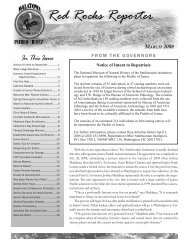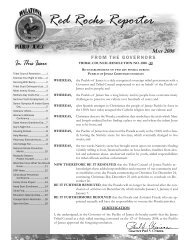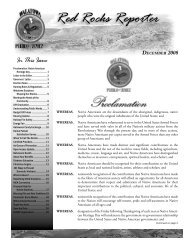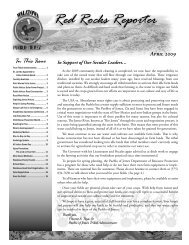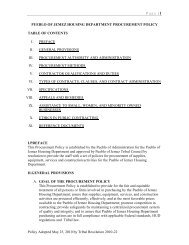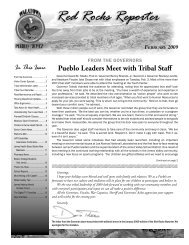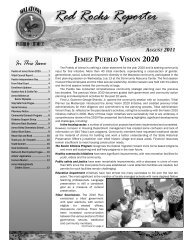You also want an ePaper? Increase the reach of your titles
YUMPU automatically turns print PDFs into web optimized ePapers that Google loves.
Page 16 <strong>March</strong> <strong>2012</strong> <strong>Pueblo</strong> <strong>of</strong> <strong>Jemez</strong> Red Rocks Reporter<br />
EDUCATION<br />
National Indian Education Association Legislative Summit<br />
Submitted by Wilmur Toya, AmeriCorps VISTA Member<br />
The annual National Indian Education Association (NIEA)<br />
Legislative Summit brings NIEA members and Native education<br />
advocates from around the nation to Washington, D.C. to unite as<br />
one voice in Congress and the White House. The gathering from<br />
Feb. 13 through 16 provided analysis on NIEA’s federal public<br />
policy priorities affecting families, schools and communities. Many<br />
US Congressional members and national organizations serving<br />
Native students presented their plans for moving forward with<br />
Native education policies in the upcoming year.<br />
With the passage <strong>of</strong> President Barack Obama’s Executive<br />
Order (EO) 13592: Improving American Indian and Alaska Native<br />
Educational Opportunities and Strengthening Tribal Colleges and<br />
Universities on Dec. 2, 2011, it was important to express support<br />
for strengthening our educational systems.<br />
The Native Culture, Language and Access for Success in<br />
Schools Act (Native CLASS Act; S. 1262; HR 3568 and HR 3569)<br />
moves toward a federal education policy that fulfi lls federal<br />
trust responsibility and supports Native self-suffi ciency and selfdetermination.<br />
The Native CLASS Act comprehensively restructures<br />
the federal government’s role in Indian education, while empowering<br />
tribes to assume greater roles and responsibilities in educating<br />
Native children. NIEA supports several initiatives in the Native<br />
CLASS Act as part <strong>of</strong> the reauthorization <strong>of</strong> the Elementary and<br />
Secondary Education Act (ESEA) (formerly No Child Left Behind.)<br />
These initiatives address the following priorities:<br />
Strengthening tribal control <strong>of</strong> education. As a matter <strong>of</strong> right,<br />
why would Native peoples want their children’s education<br />
controlled by non-Natives? As a practical matter, Native and<br />
local control will yield better results, both in cultural vitality and<br />
success.<br />
Investing in cultural and language revitalization. Native students<br />
who have strong foundations in their languages and cultures<br />
perform better academically. At the same time, Native culture<br />
is preserved not in books, but in the minds <strong>of</strong> our children.<br />
Developing and retaining native teachers, administrators<br />
and education leaders. A strong core <strong>of</strong> Native education<br />
pr<strong>of</strong>essionals is an essential element <strong>of</strong> building Native<br />
education. Native students who have Native teachers not<br />
only receive instruction, but also have people who intimately<br />
understand the culture and who can be role models. Studies<br />
show that role models can be the single most important factor<br />
in students’ motivation and success.<br />
Addressing the needs <strong>of</strong> all Native students. Federal policy<br />
should address the needs <strong>of</strong> Native students in BIE, tribal,<br />
public and private schools, as well as in both reservation and<br />
urban settings.<br />
Department <strong>of</strong> Education Director Kevin Shendo and VISTA Volunteer Wilmur<br />
Toya with NM Senator Tom Udall (top) and Hawaii Senator Daniel Inouye (below.)<br />
“Going between buildings or catching cabs to our next meeting, and walking<br />
past the US Capitol and Supreme Court buildings are things I will never forget,”<br />
Wilmur says. “This summit provided information about keeping education strong<br />
in Native American schools and the importance <strong>of</strong> federal support <strong>of</strong> Native<br />
education. This fulfillment <strong>of</strong> the federal government's trust responsibility is<br />
also smart policy because it strengthens Native communities, languages and<br />
cultures; it empowers Native peoples to be self-sufficient, and yields a multi-fold<br />
economic return back to tribes and tribal communities in the long run.”<br />
Kevin Shendo, <strong>Jemez</strong> Department <strong>of</strong> Education Director, and I<br />
attended the summit to further our knowledge and understanding<br />
<strong>of</strong> the impact <strong>of</strong> tribal and local control <strong>of</strong> schools in <strong>Jemez</strong> <strong>Pueblo</strong>.<br />
After a welcome and board introductions, NIEA Board <strong>of</strong> Directors<br />
President Quinton Roman Nose gave the State <strong>of</strong> Native American<br />
Education Address.<br />
General sessions discussed educational issues within native<br />
communities. The Language and Culture/Native Teachers group<br />
discussion focused on why children who speak their Native<br />
languages may be afraid to speak it, the loss <strong>of</strong> language as a<br />
whole, and teaching language at an early age. One important issue<br />
was that many communities do not <strong>of</strong>fer enough opportunities<br />
for students to speak their language and converse with elders.<br />
Communities need Native speakers who can work in schools<br />
without certifi cation hurdles. There are also needs for more stories<br />
to be translated to tribal languages, placing local culture experts<br />
in schools, hands-on training in culture-based experiences, and<br />
support for families to help reinforce Native languages at home.<br />
A visit to Capitol Hill included a meeting with New Mexico<br />
Senator Tom Udall to get support and feedback on Native<br />
education priorities and the Native CLASS Act. Later, William<br />
Mendoza, Director <strong>of</strong> the White House Initiative on American<br />
Indian and Alaska Native Education, met with us regarding funding<br />
to establish tribal education departments and agencies similar to



